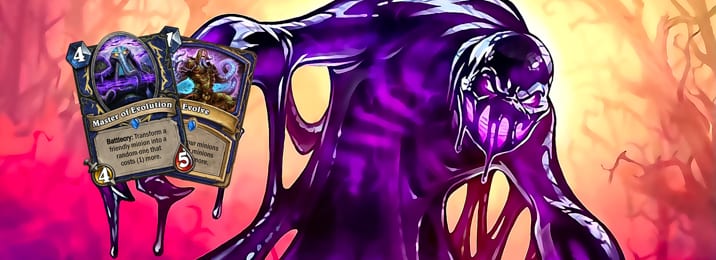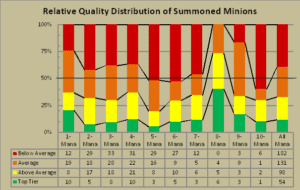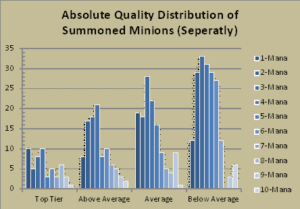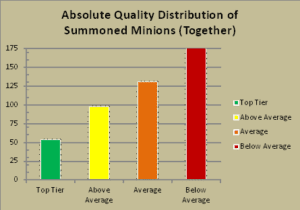
Forbidden Shaping Infographic (Standard – Kraken)
by OtakuMZ - 8 years ago show comments
Introduction
First of all, sorry for taking so long to prepare this infographic. You may see why, it is HUGE! I analyzed 465 minions and had to put all of these into one sheet. My computer refused service with such a high dataload more than once, but now it is finished, the Forbidden Shaping infographic. The next infographic will most likely also take a while, as my real life, more precisely work, will be very stressful throughout June. So exspect me back wit hanother of these graphics at the beginning of July. I might be able to squeeze in a small one in between but I can’t make promises. As always, my analysis is intendend for Standard play mode only.
The Card

Forbidden Shaping is a card which was not conceived very well by the community when first announced. It is very heavy on the RNG side and most of the times you get less from it than you paid for. One cause of this is missing the (mostly) beneficial battlecries as they do not Trigger when “summoned” in comparison to be “played” from hand. Deathrattles are still a thing but good dearthrattles are rare since GvG and Naxx left the Standard format. One question could not be answered until the card was actually played: does the flexibility make up the downsides of RNG and getting potentially lower value minions.
With about a month in the Expansion, a lot of Control Priests started to run one or two copies of Forbidden Shaping exactly because of ist flexibility. In Control Priest, you quite frequently have awkward turns with a lot of floating mana. In these circumstances, Forbidden Shaping can come in really handy. With my analysis, I will try to provide to you the statistics that should enable you to evaluate the best turn or mana pool to play the card. The most important graph for this is the one at the top of the whole Infographic. It shows the relative distribution of card qualities divided in:
- top tier – the best of the best
- above average – good stats for the cost or favorable card powers
- average – vanilla cards or inferior cards with positive effect
- below average – inferior stats or bad stat Distribution; drawback card effects
I adapted the subcategories from a post in the hearthhead.om forums by HSSpacewizard. Btw, he made an excellent guide and video on the same topic which is very worth checking out. Average minions are defined as vanilla stat minions, e.g. a 4-Mana minions with 3/5 or 4/4. Vanilla minions that are less favorable for control decks, e.g. a 4-mana 5/3, fall in the below average category by this evaluation as well as inferiorly stated minions or one with a negative effect. Like every rating System, this one also has its flaws but in the end it is a good approximation of reality. Anyway, there are always situations where a below average card can shine or a top card will not be optimal – just keep that in mind.
I evaluated some cards differently than HSSpacewizard, e.g. Tournament Medic, which he evaluated below average in contrast to my above average rating. In this example, I simply find that the card is highly beneficial to the playstyle of most priest decks in the meta, with them being almost exclusively control style decks. Another one is Ancient Shade. Despite being a more an aggro card, 7/4 without the negative battlecry is simply very good. Evaluating it, as he did, as average does not pay total credit to this card despite being not in line with the playstyle. Of course you can argue if it is top tier or above average. In the end, all of these differences were of minor consequences to the overall picture. All in all, I did disagree with him in about 20-25 cards, a lot of them were cards with any aura or trigger effects, that I found very beneficial. Sometimes I got the impression, that he forgot just that negative battlecries do not have any impact an underrated cards because of that (e.g. Ancient Shade). I also encountered two errors related to nerfed cards in his updated version (BGH and Ironbeak Owl), which probably will be corrected in the days to come. I highly recommend following the link to his article. It complements my more visual approach very well. It is also overall excellently made, shoutouts to him!
As I said, my infographic, which I began before I even saw his article, has a more visual approach which made it the biggest infographic of mine to date and most likely the largest I will ever make with more than 460 cards!
An important note: Rating of cards takes into account, that you play a control oriented game (as most priest decks do). You can use the column plot which you can find at the top of the infographic, to some extend even for slower midrange decks. This enables you to apply it for slower Shaman cards, e.g. Evolve and Master of Evolution, to predict teh likelyhood of the evolve’s effect being beneficial. Evaluating Shifter Zerus is not possible though, as he will benefit from battlecries. For other, more tempo oriented cards, e.g. Faceless Summoner, it is less suited because aggressive Cards become more useful the faster the decks are. Anyway it is very likely that I will make a separate infographic for this specific card in the future.


Ranking: 8-Mana Is the Winner, 10-Mana Is Worst
Looking at all the numbers, you can make out a ranking, which mana is the most effective to play Forbidden Shaping on. It is clearly the 8-Mana spot. There are simply good minions and no bad ones in this cost category. 9-Mana and 1-Mana follow with a gap taking 2nd and 3rd place. 4-Mana, 3-Mana and 2-Mana are the upper middle ranked spots while 7-Mana an d 6-Mana hold the lower middle (in this order). 5-Mana is rated second last and 10-Mana is in the worst place right now. This changed at least my plays a bit. If I sit at 10 mana, I will always heal first, then I play Forbidden Shaping. The outcome is simply highly superior. For other costs you cannot make euqal assumtions but with the help of the graph you can decide whether to Play Forbidden Healing or do another play.
Below, I added another two Graphs, which might be of interest to some of you, but did not make the cut for the big infographic
With this I will conclude and I hope you enjoy the infographic and my analysis. If you like it and the rest of my work, leave me some nice words on twitter @OtakuMZ1978 and give me a follow if you want to see new content announced.
Good luck and have fun!




I think you don’t give the fact that you spend all of your mana enough thought. Avianna and Confessor will Most likely die before their effects will come in Handy making them extremely poor vanilla creatures. Just think about it This way: how often would you play there two without using their effect on the Same turn?
You are right. But I count in that you might be able to set things up the way, that you might be ble to protect Confessor or Avianna one turn. Anyway, I might have overevaluated them. Tahnks for the feedback!
Are the cards equally random or are they class-weighted like the discovery keyword? (Of course we know they are weighted to whichever card you want to see the least).
I do not think class cards are weighted higher like it is the case with discover cards.